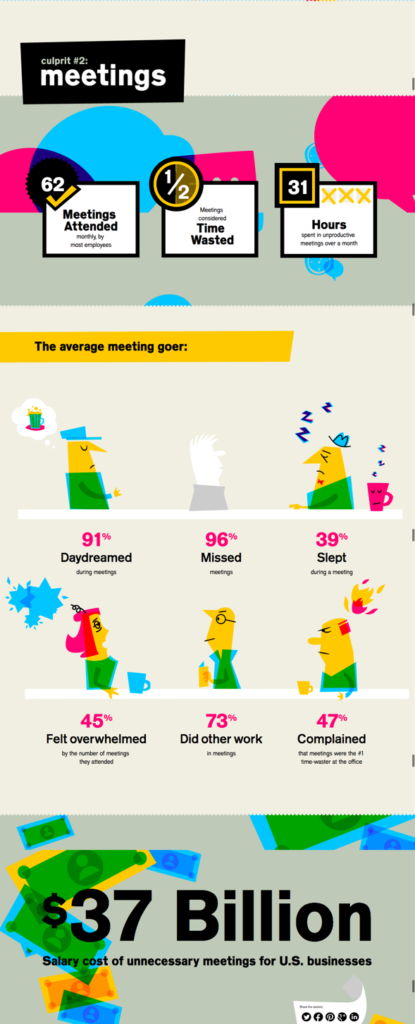Time, they say, is money.
In recent years, the concept of time – and competing for it in the noise of technological distractions – has become perhaps the greatest challenge facing the business world. As Silicon Valley continues to pump more and more cash into capturing (and holding) our attention, the battle to be heard in a sea of professional attention stealers is extreme.
What’s more, this ‘race to the bottom of the brainstem’, as ex-Google Design Ethicist Tristan Harris calls it, has serious repercussions. The competition to capture attention subjects us – and our staff – to repeated interruptions that effectively bulldoze or monopolize our attention. All. Day. Long.
As a result, attention spans are reducing (or so some academics are arguing, at least). Research also suggests it takes 23 minutes on average to refocus ourselves when we’re interrupted from task. Worse still, we’re actually self-interrupting on average every 3.5minutes. You’ve probably already interrupted yourself in the time it’s taken to read this intro.
The bottom-line is, time is now the currency of a digital age. It’s also getting harder and harder to capture. The competition for it is impacting productivity, concentration, innovation, and the happiness of ourselves and our employees.
As employers, businesses, and individuals, we all need to radically rethink how we perceive, measure, protect, and value time.
The shift to a time-based currency
Before the explosion of social media and consumer technology, the premise of the business marketplace was relatively simple: we were competing for consumer cash. We wanted to get people to buy our product or service.
Of course today, ultimately, the end-goal remains the same. Business organizations are looking to make money; however, the route to that end-point is far more complex.
Empowered consumers now have the power of choice, access to more information, and an eye-watering number of touchpoints on the journey. Academics are divided on the exact number, but there are estimates that the average American sees around 4,000 marketing messages a day – some resources estimate this to be as high as 10,000. And the more time we give to a particular business, brand or product, the more familiar it becomes – and the more likely we are to purchase.
But don’t I choose how to spend my time?
OK, so everyone is competing for a piece of our time. But if this is simply a new form of ‘currency’, isn’t it simply up to us to choose whether to spend – and where? Don’t we retain the freedom of choice?
Not exactly.
“There’s a hidden goal driving the direction of all of the technology we make, and that goal is the race for our attention. Because every new site — TED, elections, politicians, games, even meditation apps — have to compete for one thing, which is our attention, and there’s only so much of it. And the best way to get people’s attention is to know how someone’s mind works.” (Tristan Harris, co-founder of Time Well Spent.)
Behind every platform, teams of engineers are researching and testing how the mind works in order to capture, steer, and manipulate how we think.
Couple that with constant screen switching and a micro marketing device in every pocket, and our ‘always on’ way of living leaves us vulnerable to being almost continuously (if subconsciously) coerced –giving away time we never intended or planned to in the first place.
Tristan Harris explains this more in his TED talk, below.
The power of technology – which is not designed to be neutral – is far-reaching and even addictive. It influences and changes our behaviors, attitudes, and perception of the world, in ways we may not fully understand. This affects not only our personal lives, but also our performance, attention, and motivation in the workplace.
How can we protect employee time?
We may understand that time has become the most sought-after personal ‘commodity’ we have. We may even accept that we are persuadable and be attuned to how technology sets out to manipulate us. But ensuring that the time we have is spent wisely isn’t easy. As employers and managers, they are ways to support our employees.
1.) Shift away from quantity, to quality
Time used to be the benchmark of performance – particularly in the industrial era, when clocking in and out was the norm, and the quantity of hours worked was the single measure of employee output. Employees give time, and we assume a corresponding outcome. Time into the business = value to the business. Right?
Actually, in a world increasingly dominated by knowledge work, this is no longer the case.
We’ve written before about the figures released by Gallup on employee engagement – which show that although our employees may be turning up and physically present for a defined period of time, that doesn’t necessarily equate to productivity or business outcomes. They may be there, but they’re mentally checked out.
“The big lie of the knowledge-working world is that we are really doing eight hours of work in our eight-hour days. The truth is we’re doing about two-three hours of real work, just taking eight hours to do it.”
(Quote from Stephan Aarstol, co-founder and CEO of Tower Paddle Boards, who controversially introduced 5-hour days for his employees: resulting in the company becoming one of the fastest-growing in the nation.)
The value of time shouldn’t be quantity; it should be quality. The outcome of time, not the amount.
Gauge performance against output-based KPIs, rather than hours worked. Set out performance-related benchmarks and trust employees to achieve these in their own time. We all have our own natural peaks of productivity or creativity during the day: be flexible with working hours and what work needs doing when.
By cultivating this culture of trust and giving employees autonomy, you’ll empower employees to maximize their time and work to their own rhythm. This, in turn, instills higher levels of engagement and happiness – with a sense of ownership over work, and time.
2.) Protect work-life balance
Don’t just protect and maximize time spent in work: play an active role in safeguarding employee personal time also.
The topic of work-life balance has risen to the top of the management agenda and for good reason; its ties with mental health and employee well-being are well-documented. Workplaces that support work-life balance also see improved levels of employee engagement, lower rates of staff turnover, decreases in workplace errors, and a boost to innovation, creativity, productivity, and turnover.
Tackle the damaging culture of unpaid overtime that is proven to have hugely detrimental effects on employee productivity, health, and wellbeing. (Reports show this is an epidemic around the world, including in Australia, the UK, and Japan.) Lead by example, with senior management leaving the office on-time, taking annual leave allowance, and leaving their desks for lunch. This encourages staff to do the same.
Protecting valuable personal time not only promotes work-life balance and avoids the dangers presented by burn-out, but will see you gain more from the time employees are present in work.
3.) Allow staff to ‘disconnect’
Closely related to the topic of work-life balance is the idea of enabling staff to ‘switch off’.
Technology may have revolutionized how we work and interact within the workplace, but it comes with a downside. Many of today’s digital workplace solutions are designed for ‘point-in-time’ communication: cutting down on internal email and connecting us across the boundaries of departmental silos, office locations, or time.
However, ‘instant’ messaging also lends itself towards instant responses – and more interruptions. If we are showing as ‘online’, we feel obligated to acknowledge and respond to notifications as they pop up. Employees are embracing the BYOD culture and increasingly downloading corporate apps onto their personal mobile phones. Even when we’re out the office or not working, we never have the chance to fully disconnect from work.
Some enterprise software developers are catching on to this dilemma, giving us the power to ‘silence’ interruptions, to ‘appear offline’ or ‘busy’ in order to prevent unwanted communication. However, the culture of an always-on society makes a digital detox a challenge.
Encourage employees to logout, sign off, or put the proverbial ‘Do Not Disturb’ sign up from time-to-time. Consider following the famous example of Daimler, who auto-delete emails for employees who are away from the office on annual leave. This practice should apply both outside and during working hours. When we have a project deadline or important task that requires our full attention, technology should support that – not hinder it with interruptions.
4.) Streamline and unify the digital workplace
Technology now underlines almost every processes and workflow within our workplaces. However, as the technology stack continues to grow, the irony is that we’re actually becoming less efficient – and exposing our staff to technology fatigue.
The employee experience of the digital workplace should be built on the same principles of user experience that we champion for our customers. Claim back time lost to scouring multiple drives, cloud storage, email inboxes, or jumping across different platforms and applications. Where possible, reduce the number of different tools or applications your employees have to use to find information, communicate with colleagues, or perform role-specific tasks.
Does it make sense to have employees communicating via Skype, Yammer, Slack, and iMessage, depending on their department or device? Are you exposing your business to not only wasted time and duplicated effort, but potential compliance violations by having incorrect or outdated information stored in various silos within your business?
Work with IT decision makers in your business to unify your technology stack. Use integration functionality or single sign-on to get your different tools and applications working intuitively together. A collaborative intranet platform that brings together all the different tools or platforms in your business, providing a single, centralized point of access to everything your employees need, is an ideal solution – saving valuable time and improving employee satisfaction.
5.) Make the time taken from employees ‘time well spent’
By nature, we require and take time away from our employees. This may be for strategy or check-in meetings, for example, or each time we publish an internal memo or email out a policy update.
Let’s adopt the mantra of ‘time well spent’ and consider if that time we take is worthwhile to both the individual, and the business.
First, cut down on unnecessary digital noise. Expose employees to information that is timely and relevant to them, rather than mass-marketing to all. Use principles of personalization and tailoring for internal communication to ensure you’re getting the right content or message in front of the right people, saving time and distractions created by irrelevant comms.
Address the ‘evil of meetings’. According to a study by Atlassian, employees waste 31hours a month on average in pointless meetings – at a significant cost to US businesses:

“Being selfish with your time at work isn’t necessarily a selfish act. When it comes to unnecessary meetings, selfishness can lead to more productive working hours for everyone.” (Sujan Patel, ‘5 ways to reduce internal meetings by 75%’, Huffington Post)
Embrace agile and collaborative ways of working by connecting colleagues across the boundaries of department or office. Perhaps one staff member in Singapore has a particular customer challenge they’re struggling to resolve – but there’s a colleague in the New Jersey office who has come across this before and can help resolve it.
By connecting those individuals simply and easily – with a centralized employee directory, or a shared collaborative space where employees can ask questions, search for keywords or topics, or identify peers with specific skillsets – you save valuable time and reduce duplication of effort. This is an approach increasingly embraced by Scrum agile development teams, where daily stand-ups and a cross-functional team set-up allows individuals to air any blockers standing in the way of them achieving their goals, and connect with others who may be able to support them.
Finally, empower your employees with the autonomy and freedom to say, “no”, or challenge where – and how – they spent their time. If they have the responsibility and confidence to say “I think my time would be better spent here, rather than there” – you will save potential wasted time and motivate employees to do more with the time they have.
The ‘net new positive contribution’ of time
In his TED Talks and at the foundation of his ‘Time Well Spent’ movement, Tristan Harris argues the case for approaching technology development with the mindset of its “net new positive contribution to human life”. The idea is to step back and consider the wider impact and value of the technology we produce.
Perhaps it’s time for us to approach time in the workplace with the same mindset.
What is the ‘net new positive contribution’ of this meeting, or that admin task? If we are giving up time, or asking our employees to, is the outcome worth the investment? How can we protect and increase the net value of time by minimizing interruptions, time wasting, or distractions?
By placing time at the top of the priority list, we’ll see a knock-on impact not only on business outcomes but the overall engagement and well-being of our employees – and ourselves.




